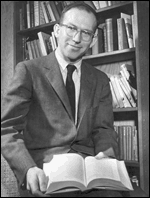 |












|

|

 illiam Edgar
Bowers, Jr., one of the finest American poets of the 20th century, was born
on March 2, 1924, in Rome, Georgia. The son of a plant nurseryman, William
Edgar Bowers, Sr., and a teacher, Grace Lydia Anderson, the poet had one
sibling, Lydia Eleanor Bowers, who was born in 1926. The Bowers family lived
in several of the southeastern states until the Great Depression forced
them to move back to Georgia, this time to Decatur, where they were taken
in by Grace Bowers's elder sister, Jennie Anderson. It was the poet's Aunt
Jennie who would later serve as the model for his poem “Mary,”
a moving portrait of a Southern schoolteacher. illiam Edgar
Bowers, Jr., one of the finest American poets of the 20th century, was born
on March 2, 1924, in Rome, Georgia. The son of a plant nurseryman, William
Edgar Bowers, Sr., and a teacher, Grace Lydia Anderson, the poet had one
sibling, Lydia Eleanor Bowers, who was born in 1926. The Bowers family lived
in several of the southeastern states until the Great Depression forced
them to move back to Georgia, this time to Decatur, where they were taken
in by Grace Bowers's elder sister, Jennie Anderson. It was the poet's Aunt
Jennie who would later serve as the model for his poem “Mary,”
a moving portrait of a Southern schoolteacher.
 Eventually
the poet's father established a plant nursery near Stone Mountain, Georgia,
where he and his family raised and sold azaleas, camellias, daphnes, and rhododendrons. Stone Mountain Gardens,
as the business was called, and its surrounding acreage served as the setting
for some of Bowers's most important works, including his sequence “Autumn
Shade” and his richly detailed pastoral poem “Elegy: Walking the
Line.” Eventually
the poet's father established a plant nursery near Stone Mountain, Georgia,
where he and his family raised and sold azaleas, camellias, daphnes, and rhododendrons. Stone Mountain Gardens,
as the business was called, and its surrounding acreage served as the setting
for some of Bowers's most important works, including his sequence “Autumn
Shade” and his richly detailed pastoral poem “Elegy: Walking the
Line.”
 While
Bowers and his sister were growing up, the family continued to live in Decatur,
where the poet attended local schools. At the age of nine, Bowers first heard Christina Rossetti?s poem “Who Has Seen
the Wind?” and was captivated by its meter and rhyme. At Decatur Boys?
High School, Bowers received what he once described as “an old-fashioned
education” in poetry, reading the works of William Cullen Bryant, Walter
Scott, Alfred Lord Tennyson, Robert Browning, and Edna St. Vincent Millay.
He joined with his high school friends to form a writers' club that produced
a literary magazine as well as theatricals in which the writers performed. While
Bowers and his sister were growing up, the family continued to live in Decatur,
where the poet attended local schools. At the age of nine, Bowers first heard Christina Rossetti?s poem “Who Has Seen
the Wind?” and was captivated by its meter and rhyme. At Decatur Boys?
High School, Bowers received what he once described as “an old-fashioned
education” in poetry, reading the works of William Cullen Bryant, Walter
Scott, Alfred Lord Tennyson, Robert Browning, and Edna St. Vincent Millay.
He joined with his high school friends to form a writers' club that produced
a literary magazine as well as theatricals in which the writers performed.
 Bowers
began his undergraduate education at the University of North Carolina at
Chapel Hill, but the Second World War interrupted his studies, and he soon
found himself in the Army. Upon his discharge in April, 1946, he returned
to Chapel Hill, earning his bachelor's degree with a double major in French
and German, and then completed his education with a doctorate in English
at Stanford University in 1953. Like his mother and aunt, Bowers became
a teacher, first at Stanford, then at Duke University and Harpur College
(now part of SUNY Binghamton), and finally, from 1958 to 1991, at the University
of California, Santa Barbara. Bowers
began his undergraduate education at the University of North Carolina at
Chapel Hill, but the Second World War interrupted his studies, and he soon
found himself in the Army. Upon his discharge in April, 1946, he returned
to Chapel Hill, earning his bachelor's degree with a double major in French
and German, and then completed his education with a doctorate in English
at Stanford University in 1953. Like his mother and aunt, Bowers became
a teacher, first at Stanford, then at Duke University and Harpur College
(now part of SUNY Binghamton), and finally, from 1958 to 1991, at the University
of California, Santa Barbara.
 During
his many years as an English professor, Bowers periodically returned to
Georgia to visit his mother near Stone Mountain, where she lived in a house
completed shortly after his father's death in 1953. It was at Stone Mountain
that Bowers would immerse himself in the Georgia landscape, finding in it
the inspiration for many of his most memorable poems. During
his many years as an English professor, Bowers periodically returned to
Georgia to visit his mother near Stone Mountain, where she lived in a house
completed shortly after his father's death in 1953. It was at Stone Mountain
that Bowers would immerse himself in the Georgia landscape, finding in it
the inspiration for many of his most memorable poems.

|
  |

Edgar
Bowers at age two years, nine months
William
Edgar Bowers, Sr.
Grace
Bowers as a young woman
Grace
Anderson and Jennie Anderson
Jennie
Anderson
Eleanor
Bowers, Grace Bowers, Edgar Bowers
Edgar
Bowers and Grace Bowers near Stone Mountain
Plat
of the Bowers's property near Stone Mountain
Grace
Bowers hoeing at Stone Mountain Gardens
Obituary
for William Edgar Bowers, Sr.
 THE
POEMS THE
POEMS




"Mary"
"Elegy:
Walking the Line"
"Autumn Shade:
2"
"Dedication for a House"
"Variations
on an Elizabethan Theme"
|

![]()
![]()
![]() THE
POEMS
THE
POEMS![]()
![]()
![]()
![]()
